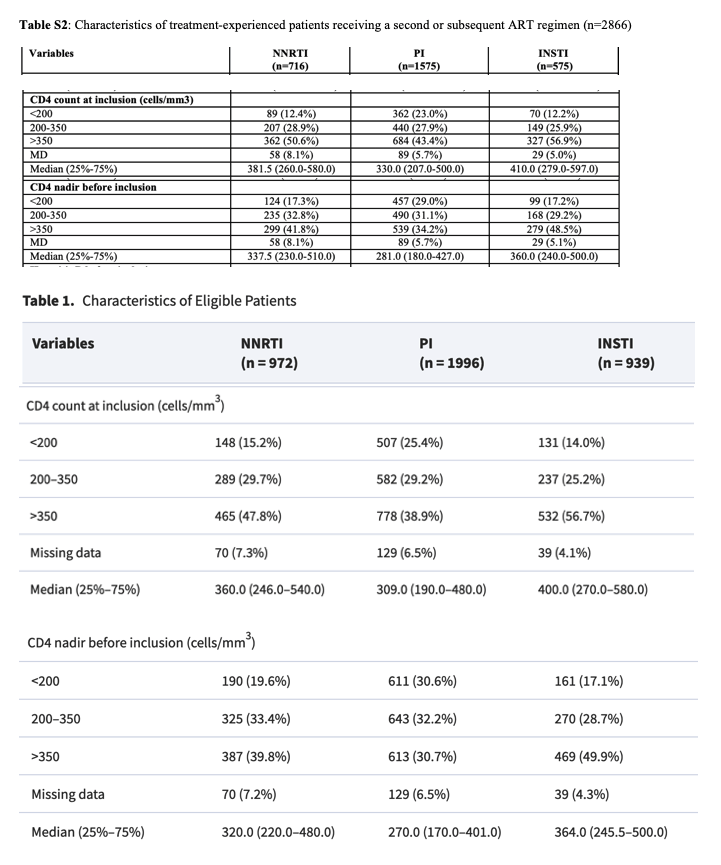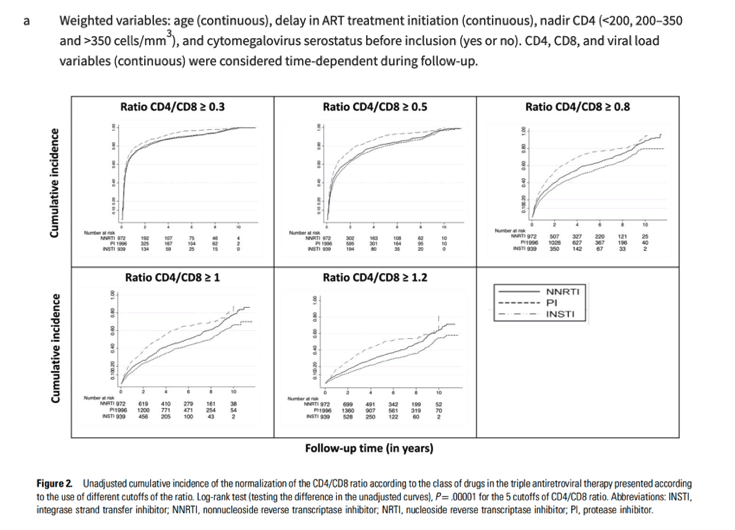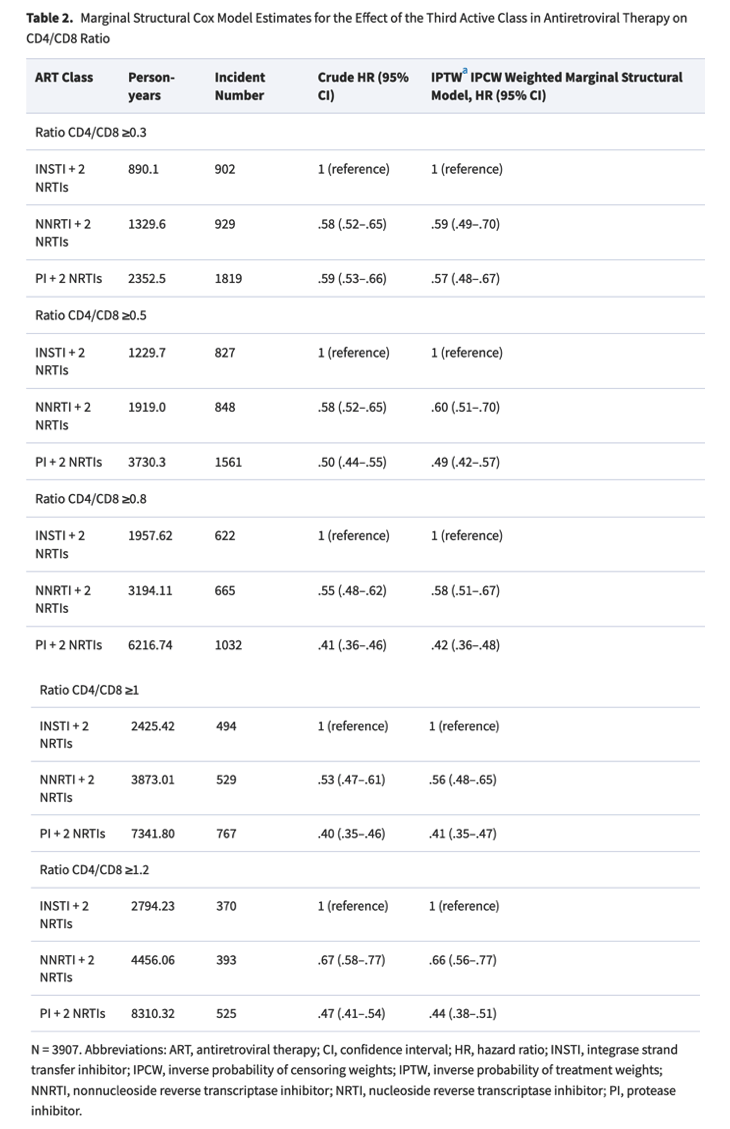| |
CD4/CD8 Ratio Outcome According to the Class of the Third Active Drug in Antiretroviral Therapy (ART) Regimens: Results From the Quebec Human Immunodeficiency Virus (HIV) Cohort Study
|
| |
| |
Download the PDF here
Download the PDF here
Clinical Infectious Diseases 01 February 2023
Conclusions
Our study showed that INSTI-based ART seems better than NNRTI- and PI-based regimens for normalizing the CD4/CD8 ratio, a potential marker of reduced immune activation, among ART-treated PLHIV. Integrase strand transfer inhibitors are newer therapeutic agents that have demonstrated their virological efficacy with a higher genetic barrier to resistance among both treatment-naive patients receiving a first treatment and ART-treated PLHIV. Due to the association between a persistently low CD4/CD8 ratio and morbidity among PLHIV, it is important to determine the role of therapeutic classes in normalizing the CD4/CD8 ratio.
In our study with PLHIV treated with a first (n = 1041) or a subsequent ART regimen (n = 2866), we did find that INSTIs were better than both NNRTIs and PIs for the normalization of the CD4/CD8 ratio globally and in both groups of first and subsequent treatment. Although NNRTIs were better than PIs for CD4/CD8 ratio normalization, they did not reach the levels of normalization achieved with INSTIs.
In our study, the effect of INSTI-based ART on CD4/CD8 ratio recovery appears to be explained more strongly by a greater increase in CD4 rather than a decrease in CD8.
For the association between ARVs and CD4 (≥350 cells/mm3), the weighted HRs were .38 (95% CI: .20-.72) for patients exposed to NNRTI + 2 NRTIs and .44 (95% CI: .23-.83) for those exposed to PI + 2 NRTIs compared with the patients exposed to INSTI + 2 NRTIs. For the association between ARVs and CD8 (≤500 cells/μL), the weighted HRs were 1.25 (95% CI: .45-3.46) for patients exposed to NNRTI + 2 NRTIs and 1.67 (95% CI: .65-4.24) for those exposed to PI + 2 NRTIs compared with the patients exposed to INSTI + 2 NRTIs. Results were similar when the CD8 variable was dichotomized using a cutoff of 1000 cells/μL.
When the analysis was restricted to treatment-naive patients receiving their first treatment (n = 1041), the weighteds HR for the CD4/CD8 ratio of 1 or greater were .60 (95% CI: .47-.77) for patients exposed to NNRTI + 2 NRTIs and .41 (95% CI: .32-.51) for those exposed to PI + 2 NRTIs compared with those exposed to INSTI + 2 NRTIs (Table 3). Table 4presents the analyses restricted to patients on a second or subsequent treatment. Weighted HRs for a CD4/CD8 ratio of 1 or greater were .78 (95% CI: .66-.92) for patients exposed to NNRTI + 2 NRTIs and .57 (95% CI: .49-.67) for those exposed to PI + 2 NRTIs compared with those exposed to INSTI + 2 NRTIs.
RESULTS
Among the 3907 eligible patients, 972 (24.9%), 1996 (51.1%), and 939 (24.0%) were exposed to NNRTI + 2 NRTIs, PI + 2 NRTIs, and INSTI + 2 NRTIs, respectively. The INSTIs at inclusion were raltegravir (37.6%), elvitegravir (19.4%), and dolutegravir (43%).
The total follow-up time after inclusion was 13 640.24 person-years and 1790 of 3907 PLHIV reached a CD4/CD8 ratio of 1 or greater (13.1%; 95% confidence interval [CI]: 12.5%-13.7%) after a median duration (25%-75%) of 4.4 years (2.1-7.4). In our study, the median (25%-75%) follow-up time was 5.8 years (3.1-8.4), 4.5 years (2.0-7.4), and 2.9 years (1.7-5.3), respectively, for patients exposed to NNRTI + 2 NRTIs, PI + 2 NRTIs, and INSTI + 2 NRTIs.
Patient characteristics are summarized in Table 1. Mean (standard deviation [SD]) age was 42.9 (10.4) years, 42.5 (9.9) years, and 42.6 (11.6) years for patients exposed to NNRTI + 2 NRTIs, PI + 2 NRTIs, and INSTI + 2 NRTIs, respectively. Mean (SD) time since diagnosis at inclusion was 6.1 (6.1), 6.7 (6.3), and 5.5 (7.0) years for patients exposed to NNRTI + 2 NRTIs, PI + 2 NRTIs, and INSTI + 2 NRTIs, respectively. Median (25%-75%) CD4 nadir before inclusion was 320.0 cells/mm3 (220.0-480.0) in the NNRTI + 2 NRTIs group, 364.0 (245.5-500.0) in the INSTI + 2 NRTIs group, and 270.0 (170.0-401.0) in the PI + 2 NRTIs group.







|
|
| |
| |
|
|
|